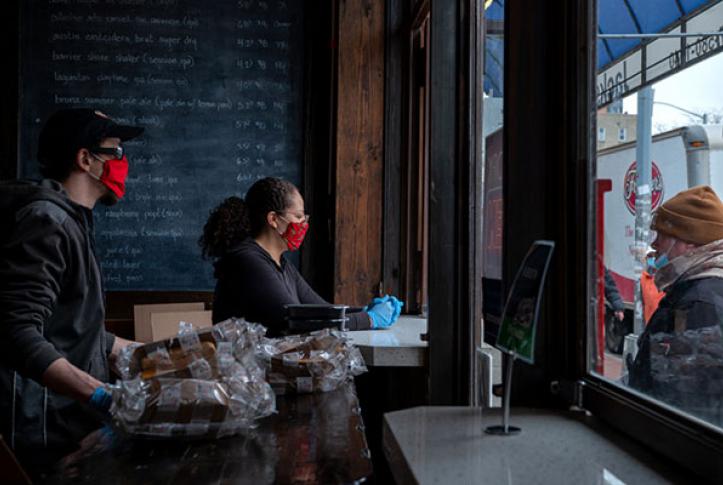As COVID-19 continues to batter New York City and the country, the burden is disproportionately borne by already vulnerable people. As is true for many other transmissible and chronic diseases (e.g., HIV, asthma, diabetes), race and class determine how we live and die from COVID-19 in the United States. Being a person of color or a low-wage-earner — or both — increases risk of exposure to the virus and the severity of the health and economic impacts. Black and Latino people in New York City have died from the virus at twice the rate of white people, according to preliminary data released by the city. New Orleans has released data showing that 70 percent to 80 percent of COVID-19 deaths have been among African Americans. The largest cluster of deaths have occurred in a Chicago prison, where the majority of the incarcerated are African American.
We also know that social distancing is a privilege. Simply put, COVID-19 has shown that knowledge workers have the option of staying home, in less-crowded living quarters, with access to food, medications and supplies, and delivery services. Service workers and manual laborers, on the other hand, lose their jobs, live in crowded spaces, often with multigenerational occupants, and frequently without access to adequate food or health care. An estimated 40 percent of Latinos have lost their jobs in New York City. For low-wage workers who have managed to keep their jobs, COVID-19 has forced them to risk their lives, as well as their health and that of their families, in ways that privileged people are spared.
While we cannot end structural racism and break intergenerational cycles of poverty in the midst of this crisis, there are three interrelated efforts that every city can undertake to provide some relief to people hit hardest by COVID-19 and to establish an improved infrastructure for addressing health beyond this crisis. None of these steps is enough on its own; they must be implemented in concert and developed at levels commensurate with local need, demand, and priorities.
Enable Social Care Providers with Technology. The social care sector is fragmented and siloed at a time when we need to be connected, coordinated, and collaborative. Unite Us, Now Pow, and Aunt Bertha are three different companies operating tech-enabled platforms that connect people and providers to social services, but we need standards for working within and across them. Let’s get more groups on board quickly and assure interoperability through standardization so that social care providers can connect with one another and integrate with health care delivery organizations. The Gravity Project, a national collaborative to improve and standardize documentation around social determinants of health in electronic health records, was making headway prior to COVID-19.
Scale the Community Health Workforce. The social care network — groups that provide food, shelter, youth programs, workforce development, transportation, and related services to vulnerable people — is fragmented and difficult to navigate. Community health workers (CHWs), who share the languages and experiences of the people they are trying to help, are best positioned to facilitate care coordination and navigation. AIRnyc, the nonprofit organization I have led for the past decade, activated our team for remote care on March 16. Our CHWs began outreach by phone, text messaging, and video to provide COVID-19 screening and health education, and to connect people with telehealth, medication, and food. We have been engaging people at three times our base rate, as anxiety rises with the rates of COVID transmission, unemployment, food insecurity, and death throughout our city. The National Association of Community Health Workers, headquartered in Louisiana, reports that other CHW-centered organizations are deploying this incredibly valuable yet undervalued workforce to similarly engage vulnerable people around the country. At the University of Pennsylvania’s IMPaCT program, Shreya Kangovi and colleagues have demonstrated CHW programs’ return on investment through randomized controlled trials. City Health Works, a New York–based group deploying health coaches, has shown the impact that this workforce can have on reducing hospitalizations for patients with congestive heart failure.
Focus on the Social Drivers of Health. In speaking with thousands of New Yorkers, AIRnyc has found that people most want help with food and unemployment benefits. That trend is likely to continue, as our already weakened social safety net further breaks down. If we fail to support people in their efforts to stay home, we increase the risk of COVID-19 transmission and its devastating impact on families and communities. Our ability to execute on the first two steps of this approach depends on our commitment to the third. A tech-enabled social care network, with strong care coordination capabilities via community health workers, must be supported with social care service providers who have capacity to meet the surge for demand in unemployment benefits and food delivery, as well as testing and contact tracing, as we move into the next phase of the pandemic and attempt to return to work.
In New York City, we are trying to implement the three elements of this approach mid-crisis. It should not have taken a pandemic for us to wake up to this inequity: some people safely at home with full refrigerators while others are lining up at food pantries or already dying or dead.




